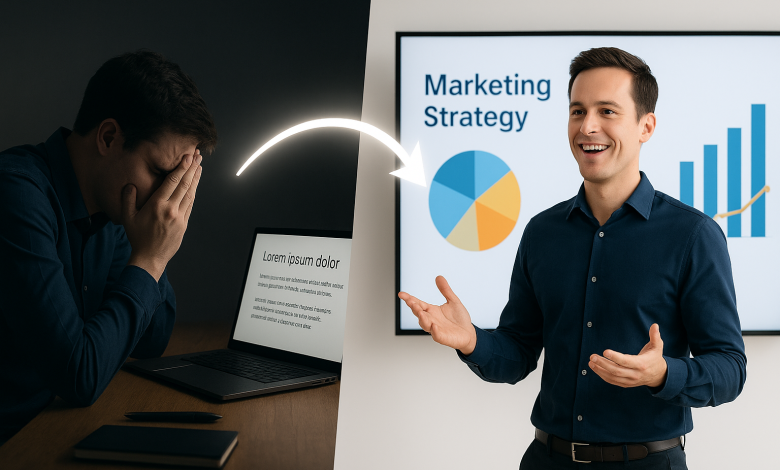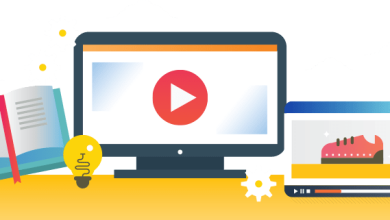
Let’s be honest. That feeling of dread is all too real. You’re staring at a blank screen. Your heart beats a little faster. You’ve just been assigned a presentation, and to make matters worse, it’s one of those classic, “boring” informative speech topics. Maybe it’s “The History of 19th Century Industrial Processes” or “An Analysis of Regional Supply Chains.” Your first thought isn’t “How can I make this great?” It’s “How can I get through this without putting everyone to sleep?”.
This panic is a universal experience for students and professionals. We’ve all felt it. We’ve all sat through “death by PowerPoint,” where the presenter just reads one dense, text-filled slide after another. And our biggest fear is becoming that person.
But what if I told you the problem isn’t your topic? And the problem isn’t you.
The problem is the process. We’ve been taught to “present information” when we should be “telling a story.” We’re so busy fighting with design tools that we have no time to find good story ideas. We spend 90% of our time fighting with design tools and 10% on our message. What if we could flip that?
This article is about the two biggest fears that make presentations so painful and how a new approach—and a new tool like Autoppt—can finally solve them.
The Two-Headed Dragon: Why We Hate Making Presentations
For most of us, making a presentation is a battle with a two-headed dragon. You defeat one, and the other one gets you.
Head #1: The “Design Trap” (The Fear of the Blank Canvas)
You open PowerPoint or Google Slides. You’re a student, a marketer, or a project manager. You are not a professional graphic designer.
But the blank slide doesn’t care. It just stares back at you.
So you start “designing.” You spend 20 minutes picking a template, but none of them look quite right. Then you spend 45 minutes trying to align text boxes, find a good font, and make the colors work. This isn’t productive work; it’s “design anxiety”. It’s that “bottleneck” where you’re terrified of creating “cluttered slides” or making “bad design choices”.
Before you know it, you’ve wasted two hours, you have three slides, and you still hate how it looks. You’re so focused on the design that you have no mental energy left for the message.
Head #2: The “Content Void” (The Fear of Being Boring)
This is the bigger, scarier head. This is the fear that your topic is just… dull.
You have the data. You have the facts. But you have no spark. You’re terrified of “losing focus,” “rambling,” or “cramming in too much information”. You know that audiences tune out fast if they’re not interested.
What you’re really looking for are story ideas.
That’s the secret. People don’t remember bullet points. They don’t remember data. They remember stories. A good story builds an emotional connection. It takes a complex idea and makes it simple and memorable. Even a data-heavy report is more powerful when you “frame data within a narrative”.
There is no such thing as a boring topic, only boring angles. The problem is, who has time to find a new angle when you’re still fighting with text boxes?
The Big Secret: Stop “Presenting,” Start Storytelling
This is the “aha!” moment. Your informative speech isn’t a report; it’s a story waiting to be told.
Think about it. Why do we make decisions? Studies show that people “make decisions based on emotion, and then rationalize their decisions afterwards”. If your presentation is just a list of facts, it “fails to engage emotionally”. It fails to connect.
A story is the tool you use to build that connection.
- It simplifies the complex: Trying to explain a complex business plan? Tell the story of one customer.
- It makes data meaningful: Don’t just show a chart of 10% growth. Tell the story of the one change your team made that sparked it.
- It builds trust: Sharing a relatable challenge builds “empathy” and “rapport”.
The goal is to find the human element. Your “informative speech topic” is just the setting. Your “story idea” is the plot. This shift changes everything.
But it brings us back to our main problem: We don’t have time for this. We’re all “busy professionals and students”. We’re too busy with the “design trap” to become master storytellers.
Until now.
The Tool That Frees You to Be the Storyteller
This is where we talk about Autoppt.
Think of Autoppt as an intelligent assistant. It’s a new AI tool designed to do one thing: handle all the “grunt work” of making slides, so you can finally “focus on the quality and substance of your content”.
It’s not just another template library. It’s an “intelligent partner” that helps you create. It solves both heads of the dragon.
Killing the “Design Trap” Instantly
First, Autoppt ends your design anxiety. Forever. You don’t need any design experience.
You have access to over 1,000 “smart templates” that “automatically adapt” to your content. Don’t like the first look? You don’t have to waste an hour. Just use the “one-click template switching” to try a new style “effortlessly”. The AI provides “intelligent layout suggestions” to make sure your slides always look professional and clean.
This alone saves hours. The “initial hurdles of design” are just… gone.
Curing the “Content Void” in 60 Seconds
This is the part that feels like magic. Autoppt helps you find your starting point.
Path 1: You have a topic. Just “enter your topic” into Autoppt. In “under one minute,” the AI will generate a complete, 20-30 slide presentation. It’s not just a blank template; it’s a fully structured presentation with an outline, ready for you to edit. The blank page panic is solved.
Path 2: You have notes. This is even more powerful. You already have your research, right? It’s probably in a Word document, a PDF, or even a simple.txt file.
With Autoppt, you can “upload documents” and “Convert PDF to PowerPoint” or “Word documents to PowerPoint” with a single click. It has “universal document support”.
Think about that. No more “content migration”. No more copying and pasting from your research paper into a text box, one slide at a time. You upload your file, and Autoppt builds the entire presentation for you based on your own notes.
The Real Benefit: It Gives You Time to Be Human
This is the “so what?”
Autoppt “automates repetitive design tasks”. It automates the “initial design phase”.
This doesn’t just make you faster. It makes you better.
By saving you all those hours of frustrating design and copy-pasting, Autoppt gives you back your most valuable resource: your time and your mental energy.
Now, you can use that “found time” to do the human work that AI can’t.
- You can “focus on your message,” not on slide design.
- You can read through the AI-generated outline and think, “What’s the story here?”
- You can refine the content, practice your delivery, and “build your confidence”.
Autoppt isn’t here to replace your ideas; it’s here to “augment human capabilities” so you can “focus on what matters—your unique ideas”.
This Is for Everyone Who Communicates
This isn’t just a tool for one group. This “time-saving advantage” is for anyone who needs to share ideas.
- For Students: Stop pulling all-nighters. Turn your research paper or lecture notes into a polished presentation in minutes. It’s the “indispensable assistant” for academic reports and group projects.
- For Business Professionals: Stop wasting your billable hours. Turn “meeting notes,” “reports,” or “financial analyses” into a “board-ready deck” instantly. This is perfect for “internal team updates” and “project progress reports”.
- For Marketers and Sales Teams: You need to be fast and look good. Instantly create “eye-catching product launch slides,” “brand promotion materials,” or “product pitches”. This “agile and collaborative workflow” helps you “iterate and refine presentations faster”.
- For Educators: Generate “engaging lesson materials” from a curriculum document. This “frees up educators to dedicate more time to teaching and student engagement”.
Plus, it supports over 100 languages. This is a truly global tool.
Stop Dreading. Start Creating.
That feeling of presentation panic doesn’t have to be your reality anymore.
The problem was never that your topics were boring. The problem was that your tools were broken. They forced you to become a bad designer instead of letting you be a great communicator.
The future of presentations is about “intelligent assistance”. It’s about using tools that handle the low-value work so you can focus on the high-value work of thinking, connecting, and storytelling.
It’s time to stop being a “frustrated designer” and start being a confident storyteller. Stop dreading that next assignment.
Ready to turn your best ideas into your best presentations?
Try Autoppt for Free today.





